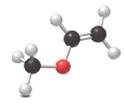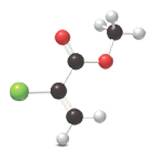
GENERAL,ORGANIC, & BIOLOGICAL CHEM-ACCES
4th Edition
ISBN: 9781265982959
Author: SMITH
Publisher: MCG
expand_more
expand_more
format_list_bulleted
Question
Chapter 13, Problem 64P
Interpretation Introduction
(a)
Interpretation:
The polymer molecule should be identified by

Concept Introduction:
Interpretation Introduction
(b)
Interpretation:
The polymer molecule should be identified by polymerization of following compound:

Concept Introduction:
Alkenes are hydrocarbon molecules that consist a carbon-carbon double bond in the molecular.
Polymers are high molecular weight macromolecules which formed from covalently bonded monomer molecules.
Expert Solution & Answer
Want to see the full answer?
Check out a sample textbook solution
Students have asked these similar questions
3. Name this ether correctly.
H₁C
H3C
CH3
CH3
4. Show the best way to make the ether in #3 by a
Williamson Ether Synthesis.
Start from an alcohol or phenol.
5. Draw the structure of an example of a sulfide.
1. Which one(s) of these can be oxidized with CrO3 ?
(could be more than one)
a) triphenylmethanol
b) 2-pentanol
c) Ethyl alcohol
d)
CH3
2. Write in all the product(s) of this reaction. Label them
as "major" or "minor".
2-methyl-2-hexanol
H2SO4, heat
3) Determine if the pairs are constitutional isomers, enantiomers, diastereomers, or mesocompounds.
(4 points)
Chapter 13 Solutions
GENERAL,ORGANIC, & BIOLOGICAL CHEM-ACCES
Ch. 13.1 - Convert each condensed structure to a complete...Ch. 13.1 - Prob. 13.1PCh. 13.1 - Complete the structure of zingiberene, a component...Ch. 13.2 - Prob. 13.2PPCh. 13.2 - Prob. 13.3PCh. 13.2 - Prob. 13.3PPCh. 13.2 - Prob. 13.4PPCh. 13.3 - Prob. 13.5PPCh. 13.3 - Prob. 13.4PCh. 13.3 - Prob. 13.6PP
Ch. 13.3 - Prob. 13.5PCh. 13.3 - Prob. 13.6PCh. 13.3 - Prob. 13.7PCh. 13.3 - Prob. 13.8PCh. 13.6 - Prob. 13.7PPCh. 13.6 - Prob. 13.9PCh. 13.6 - What products is formed in each of the following...Ch. 13.6 - Prob. 13.9PPCh. 13.6 - What product is formed when l-pentene (CH3CH2CH2CH...Ch. 13.7 - Prob. 13.11PCh. 13.8 - Prob. 13.10PPCh. 13.8 - Prob. 13.12PCh. 13.8 - Prob. 13.13PCh. 13.10 - Prob. 13.11PPCh. 13.10 - Prob. 13.14PCh. 13.11 - Prob. 13.15PCh. 13.12 - Prob. 13.16PCh. 13.13 - Prob. 13.17PCh. 13.13 - Prob. 13.18PCh. 13 - Anethole, the major constituent of anise oil, is...Ch. 13 - Prob. 20PCh. 13 - What is the molecular formula for a hydrocarbon...Ch. 13 - Prob. 22PCh. 13 - Prob. 23PCh. 13 - Prob. 24PCh. 13 - Prob. 25PCh. 13 - Prob. 26PCh. 13 - Give the IUPAC name for each molecule depicted in...Ch. 13 - Give the IUPAC name for each molecule depicted in...Ch. 13 - Give the IUPAC name for each compound. a....Ch. 13 - Give the IUPAC name for each compound. d....Ch. 13 - Give the IUPAC name for each alkene.Ch. 13 - Give the I UP AC name for each alkene.Ch. 13 - Give the IUPAC name for each cyclic compound.Ch. 13 - Give the IUPAC name for each cyclic compound.Ch. 13 - Give the structure corresponding to each IUPAC...Ch. 13 - Prob. 36PCh. 13 - Each of the following IUPAC names is incorrect....Ch. 13 - Each of the following IUPAC names is incorrect....Ch. 13 - Prob. 39PCh. 13 - Prob. 40PCh. 13 - Prob. 41PCh. 13 - Prob. 42PCh. 13 - Prob. 43PCh. 13 - Label the carbon-carbon double bond as cis or...Ch. 13 - Prob. 45PCh. 13 - Prob. 46PCh. 13 - Prob. 47PCh. 13 - Prob. 48PCh. 13 - Prob. 49PCh. 13 - Prob. 50PCh. 13 - Prob. 51PCh. 13 - Prob. 52PCh. 13 - Prob. 53PCh. 13 - Prob. 54PCh. 13 - What alkyd halide is formed when each alkene is...Ch. 13 - Prob. 56PCh. 13 - Prob. 57PCh. 13 - Prob. 58PCh. 13 - What alkene is needed as a starting material to...Ch. 13 - Prob. 60PCh. 13 - Prob. 61PCh. 13 - Prob. 62PCh. 13 - Prob. 63PCh. 13 - Prob. 64PCh. 13 - Prob. 65PCh. 13 - Prob. 66PCh. 13 - Prob. 67PCh. 13 - Prob. 68PCh. 13 - Prob. 69PCh. 13 - Prob. 70PCh. 13 - Prob. 71PCh. 13 - Prob. 72PCh. 13 - Prob. 73PCh. 13 - Are o-bromochlorobenzene and m-bromochlorobenzene...Ch. 13 - Give the structure corresponding to each IUPAC...Ch. 13 - Give the structure corresponding to each IUPAC...Ch. 13 - Prob. 77PCh. 13 - Prob. 78PCh. 13 - Prob. 79PCh. 13 - Prob. 80PCh. 13 - Prob. 81PCh. 13 - Prob. 82PCh. 13 - Prob. 83PCh. 13 - Prob. 84PCh. 13 - Prob. 85PCh. 13 - Eleostearic acid is an unsaturated fatty acid...Ch. 13 - Prob. 87PCh. 13 - Prob. 88PCh. 13 - Prob. 89PCh. 13 - Prob. 90PCh. 13 - Prob. 91PCh. 13 - Prob. 92PCh. 13 - Prob. 93PCh. 13 - Prob. 94PCh. 13 - Answer the following questions about compound A,...Ch. 13 - Prob. 96PCh. 13 - Answer the following questions about alkene C,...Ch. 13 - Prob. 98PCh. 13 - Prob. 99PCh. 13 - Prob. 100PCh. 13 - Prob. 101CPCh. 13 - Prob. 102CP
Knowledge Booster
Similar questions
- In the decomposition reaction in solution B → C, only species C absorbs UV radiation, but neither B nor the solvent absorbs. If we call At the absorbance measured at any time, A0 the absorbance at the beginning of the reaction, and A∞ the absorbance at the end of the reaction, which of the expressions is valid? We assume that Beer's law is fulfilled.arrow_forward> You are trying to decide if there is a single reagent you can add that will make the following synthesis possible without any other major side products: 1. ☑ CI 2. H3O+ O Draw the missing reagent X you think will make this synthesis work in the drawing area below. If there is no reagent that will make your desired product in good yield or without complications, just check the box under the drawing area and leave it blank. Click and drag to start drawing a structure. Explanation Check ? DO 18 Ar B © 2025 McGraw Hill LLC. All Rights Reserved. Terms of Use | Privacy Center | Accessibilityarrow_forwardDon't use ai to answer I will report you answerarrow_forward
- Consider a solution of 0.00304 moles of 4-nitrobenzoic acid (pKa = 3.442) dissolved in 25 mL water and titrated with 0.0991 M NaOH. Calculate the pH at the equivalence pointarrow_forwardWhat is the name of the following compound? SiMe3arrow_forwardK Draw the starting structure that would lead to the major product shown under the provided conditions. Drawing 1. NaNH2 2. PhCH2Br 4 57°F Sunny Q Searcharrow_forward
- 7 Draw the starting alkyl bromide that would produce this alkyne under these conditions. F Drawing 1. NaNH2, A 2. H3O+ £ 4 Temps to rise Tomorrow Q Search H2arrow_forward7 Comment on the general features of the predicted (extremely simplified) ¹H- NMR spectrum of lycopene that is provided below. 00 6 57 PPM 3 2 1 0arrow_forwardIndicate the compound formula: dimethyl iodide (propyl) sulfonium.arrow_forward
arrow_back_ios
SEE MORE QUESTIONS
arrow_forward_ios
Recommended textbooks for you
 Chemistry: Principles and PracticeChemistryISBN:9780534420123Author:Daniel L. Reger, Scott R. Goode, David W. Ball, Edward MercerPublisher:Cengage Learning
Chemistry: Principles and PracticeChemistryISBN:9780534420123Author:Daniel L. Reger, Scott R. Goode, David W. Ball, Edward MercerPublisher:Cengage Learning Chemistry: The Molecular ScienceChemistryISBN:9781285199047Author:John W. Moore, Conrad L. StanitskiPublisher:Cengage Learning
Chemistry: The Molecular ScienceChemistryISBN:9781285199047Author:John W. Moore, Conrad L. StanitskiPublisher:Cengage Learning ChemistryChemistryISBN:9781305957404Author:Steven S. Zumdahl, Susan A. Zumdahl, Donald J. DeCostePublisher:Cengage Learning
ChemistryChemistryISBN:9781305957404Author:Steven S. Zumdahl, Susan A. Zumdahl, Donald J. DeCostePublisher:Cengage Learning Chemistry: An Atoms First ApproachChemistryISBN:9781305079243Author:Steven S. Zumdahl, Susan A. ZumdahlPublisher:Cengage Learning
Chemistry: An Atoms First ApproachChemistryISBN:9781305079243Author:Steven S. Zumdahl, Susan A. ZumdahlPublisher:Cengage Learning

Chemistry: Principles and Practice
Chemistry
ISBN:9780534420123
Author:Daniel L. Reger, Scott R. Goode, David W. Ball, Edward Mercer
Publisher:Cengage Learning

Chemistry: The Molecular Science
Chemistry
ISBN:9781285199047
Author:John W. Moore, Conrad L. Stanitski
Publisher:Cengage Learning

Chemistry
Chemistry
ISBN:9781305957404
Author:Steven S. Zumdahl, Susan A. Zumdahl, Donald J. DeCoste
Publisher:Cengage Learning

Chemistry: An Atoms First Approach
Chemistry
ISBN:9781305079243
Author:Steven S. Zumdahl, Susan A. Zumdahl
Publisher:Cengage Learning

